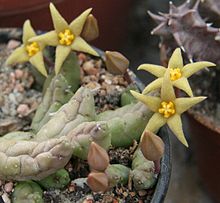Piaranthus
| Piaranthus | |
|---|---|
 |
|
| Piaranthus geminatus in cultivation | |
| Scientific classification | |
| Kingdom: | Plantae |
| (unranked): | Angiosperms |
| (unranked): | Eudicots |
| (unranked): | Asterids |
| Order: | Gentianales |
| Family: | Apocynaceae |
| Subfamily: | Asclepiadoideae |
| Genus: |
Piaranthus R.Br. |
Piaranthus is a succulent plant genus in the tribe Stapeliae, milkweed subfamily Asclepiadoideae, in the family Apocynaceae (dogbane).
It was first described in 1810. Its name is a Greek term which refers the fat, succulent flowers of the genus ("piar-" = fat, "-anthos" = flower).
The plants typically form flat, spreading mats of multiple offsetting stems. The stems are small, compact and four-edged. Tubercles (leaf remnants) appear along the four sides.
The flowers are small, fleshy, and bear five independent petals in a star shape. They appear in clusters, each flower up-turned, on a tiny inflorescence that sprouts from the tip of the stem. Each stem usually only produces a maximum of one inflorescence. The flowers of different species are in a range of colours; most emit unpleasant odours, especially the darker red or brown coloured ones.
The compact, mat-forming stems are very similar to those of the related genus Duvalia, and the two are often confused when not in flower. However the stems of Piaranthus have four sides (in cross-section), while those of Duvalia often have more.
The genus Piaranthus is restricted to the western part of Southern Africa. It occurs in arid, sandy areas, in the shade of bushes.
species transferred to other genera (Caralluma, Hoodia, Huerniopsis, Quaqua, Stisseria)
Phylogenetic studies have shown the genus to be monophyletic, and to be very closely related to the Orbea and Stapelia genera. More distantly related are the Huernia and Tavaresia genera.
...
Wikipedia
